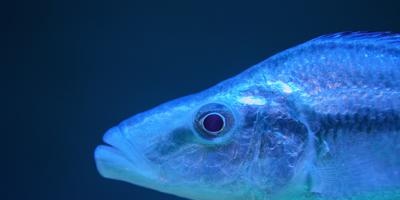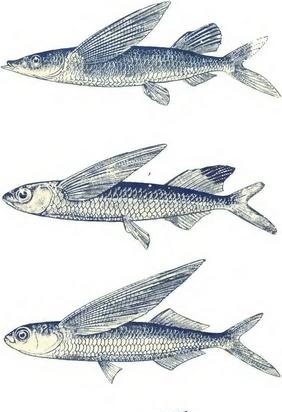|
 A fish with the intelligence of a rat? Or maybe a rat with the body of a fish? It is not so easy to decide what to call this chimerical creature created by D. Bresler of the University of California (Los Angeles) and M. Bitterman of Bryn Mawr College (Pennsylvania). A fish with the intelligence of a rat? Or maybe a rat with the body of a fish? It is not so easy to decide what to call this chimerical creature created by D. Bresler of the University of California (Los Angeles) and M. Bitterman of Bryn Mawr College (Pennsylvania).
In accordance with the laws of nature, it was to become a fish, an ordinary, not too smart Tilapia macrocephala, an inhabitant of the tropical waters of Africa. However, thanks to an unusual operation carried out at a late stage of embryogenesis, scientists managed to grow from it an artificial animal that does not exist in nature, only outwardly similar to its counterparts in appearance. The intellectual capabilities of this creature and its ability to learn far surpassed the fish's "intelligence", approaching the capabilities of advanced mammals.
The idea behind the unusual experience was based on the following considerations. If a part of the brain is removed, the function of the lost tissue can be judged by subsequent changes in the behavior and abilities of the animal. For example, if you remove a part of the bark from a young rat, an adult rat will cope with behavioral tasks much less successfully and will approach fish in its "abilities". But what if we set up the opposite experiment and try to increase the number of nerve cells in the associative structures of the brain in fish? Is it possible to get in this case the opposite effect - strengthening the intellectual capabilities of the animal? This is exactly what the researchers did by removing the embryonic brain material from embryos. Tilapia and transplanting it to other individuals of the same age and species. Additional medulla was implanted in the recipient fish in the future shaping area tectum opticum, the most important associative part of the brain, which can be called the "thinking center" of fish. Comparable in function to the mammalian cortex, tectum opticum fish are the main receiver of information coming to the brain from various sensory systems: visual, olfactory, tactile. All this made it possible to expect that an operational attempt to "improve" this structure might somehow affect the essential features of animal behavior.
Scientists managed to grow ten recipient embryos. Six of them were subjected to various behavioral tests aimed at identifying the ability to learn. The experimenters used the so-called reflex-reversible (habit-reversal) training, developed by M. Bitterman for a comparative assessment of the ability to learn in different species. In reflex-reversal experiments, the animal is initially rewarded for choosing one of two behavioral alternatives. When the preference for this rewarding alternative is fixed, that is, a conditioned reflex is developed, the conditions change in such a way that a different, opposite type of behavior is now rewarded. Experiments show that birds and mammals trained in this way show a distinct ability to improve their reversing abilities, while this is not observed in fish.
 What happened after the operation? The animals seemed to split into three groups. Two of the operated fish practically did not differ from their normal counterparts; their brains did not change in structure and size, apparently due to the fact that the implanted tissue did not take root. The other two fish showed marked improvement in learning ability, they made far fewer misses than normal individuals, but they also failed to induce a progressive reflex reversion. Finally, the two remaining fish, unlike the others, were able to improve reflex reversion with training, i.e.showed a qualitatively new property not found in ordinary fish. The severity of this effect was especially striking: it was of the same order of magnitude as in rats - animals that rank as much as three classes higher on the taxonomic scale of vertebrates. In other words, the operated animals, as it were, made a giant leap in their "intellectual" development, jumping over the good 200 million years separating the Devonian from the Cenozoic - the time during which the fish emerged from the water, amphibians, reptiles and, finally, the first mammals arose. with their incomparably more progressive cortical structure of the brain. What happened after the operation? The animals seemed to split into three groups. Two of the operated fish practically did not differ from their normal counterparts; their brains did not change in structure and size, apparently due to the fact that the implanted tissue did not take root. The other two fish showed marked improvement in learning ability, they made far fewer misses than normal individuals, but they also failed to induce a progressive reflex reversion. Finally, the two remaining fish, unlike the others, were able to improve reflex reversion with training, i.e.showed a qualitatively new property not found in ordinary fish. The severity of this effect was especially striking: it was of the same order of magnitude as in rats - animals that rank as much as three classes higher on the taxonomic scale of vertebrates. In other words, the operated animals, as it were, made a giant leap in their "intellectual" development, jumping over the good 200 million years separating the Devonian from the Cenozoic - the time during which the fish emerged from the water, amphibians, reptiles and, finally, the first mammals arose. with their incomparably more progressive cortical structure of the brain.
What was the brain of these "brilliant" fish like? The sections cited by the authors of the experiment show a distinct thickening tectum opticum - almost twice. This thickening, which was local in some of the fish, was most pronounced in those two specimens that showed a progressive ability to reverse reflexes. Researchers note the emergence in one of these fish of a qualitatively new type of neural structure that is not inherent in normal individuals. (Unfortunately, this interesting fact is not documented in their article with more detailed micrographs tectum opticum).
Do these results mean that a simple increase in the number of nerve cells above a certain norm "released by nature" can lead to significant qualitative changes in the structure and work of the brain? For the time being, such conclusions have to be handled carefully. The experimental material is still small: scientists managed to grow only 10 recipient individuals, not all of which showed the same progress. There are also certain ambiguities in the article regarding the phase of development at which the brain transplant was performed, the method of operation and suppression of the processes of rejection of the transplanted tissue.
The final confirmation (or refinement) of these results should, apparently, become an event in the coming months. If the new facts are positive, the experiment of Bresler and Bitterman can rightfully be called one of the largest scientific events of the past year. In the long term - carrying out similar operations on higher vertebrates.
The difficulties posed by the immunological barrier can be circumvented by using identical twins with an identical genotype.
However, the moral aspect of such experiments is no less important. Are such operations on human embryos permissible from a moral point of view? If in experiments on fish scientists, apparently, are sufficiently guaranteed against the danger of creating "superhuman" intelligence, then in experiments on monkeys, and even more so on humans, such a possibility becomes very real. We can only hope that further research in this area will not be classified: the scientific community must remain aware of the unexpected consequences that may entail brain transplantation in higher vertebrates.
B.V. Loginov
|
 A fish with the intelligence of a rat? Or maybe a rat with the body of a fish? It is not so easy to decide what to call this chimerical creature created by D. Bresler of the University of California (Los Angeles) and M. Bitterman of Bryn Mawr College (Pennsylvania).
A fish with the intelligence of a rat? Or maybe a rat with the body of a fish? It is not so easy to decide what to call this chimerical creature created by D. Bresler of the University of California (Los Angeles) and M. Bitterman of Bryn Mawr College (Pennsylvania). What happened after the operation? The animals seemed to split into three groups. Two of the operated fish practically did not differ from their normal counterparts; their brains did not change in structure and size, apparently due to the fact that the implanted tissue did not take root. The other two fish showed marked improvement in learning ability, they made far fewer misses than normal individuals, but they also failed to induce a progressive reflex reversion. Finally, the two remaining
What happened after the operation? The animals seemed to split into three groups. Two of the operated fish practically did not differ from their normal counterparts; their brains did not change in structure and size, apparently due to the fact that the implanted tissue did not take root. The other two fish showed marked improvement in learning ability, they made far fewer misses than normal individuals, but they also failed to induce a progressive reflex reversion. Finally, the two remaining 








